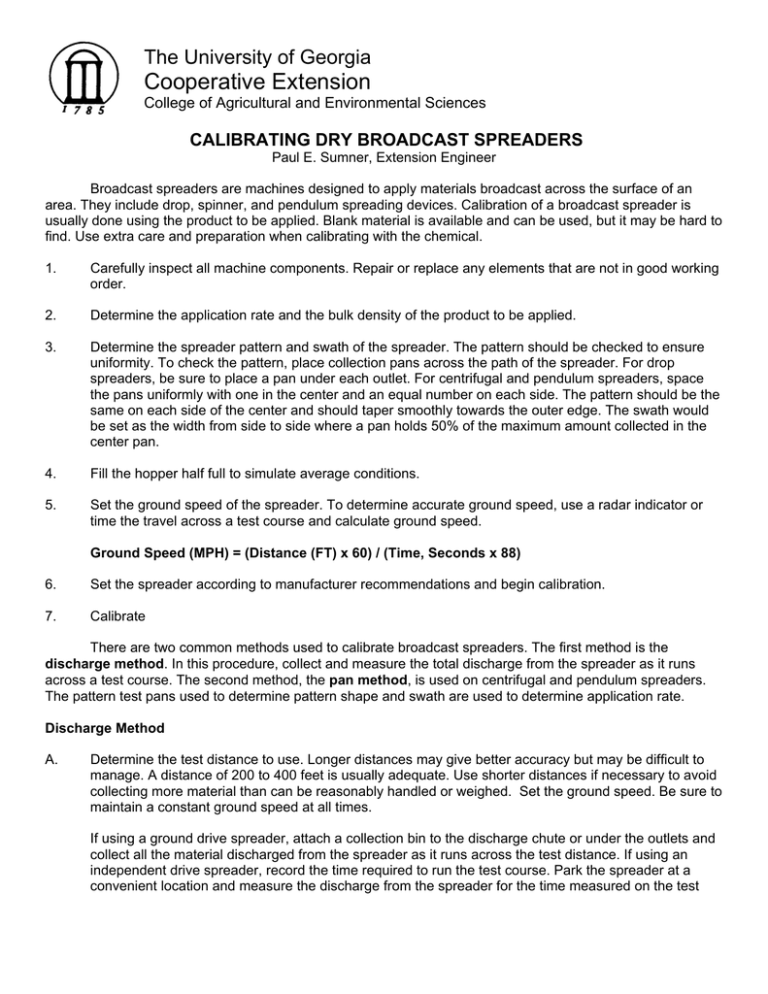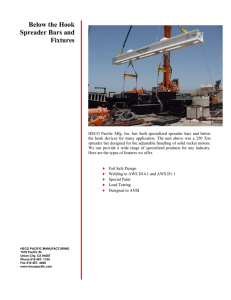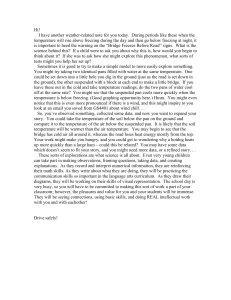Cooperative Extension The University of Georgia CALIBRATING DRY BROADCAST SPREADERS
advertisement

The University of Georgia Cooperative Extension College of Agricultural and Environmental Sciences CALIBRATING DRY BROADCAST SPREADERS Paul E. Sumner, Extension Engineer Broadcast spreaders are machines designed to apply materials broadcast across the surface of an area. They include drop, spinner, and pendulum spreading devices. Calibration of a broadcast spreader is usually done using the product to be applied. Blank material is available and can be used, but it may be hard to find. Use extra care and preparation when calibrating with the chemical. 1. Carefully inspect all machine components. Repair or replace any elements that are not in good working order. 2. Determine the application rate and the bulk density of the product to be applied. 3. Determine the spreader pattern and swath of the spreader. The pattern should be checked to ensure uniformity. To check the pattern, place collection pans across the path of the spreader. For drop spreaders, be sure to place a pan under each outlet. For centrifugal and pendulum spreaders, space the pans uniformly with one in the center and an equal number on each side. The pattern should be the same on each side of the center and should taper smoothly towards the outer edge. The swath would be set as the width from side to side where a pan holds 50% of the maximum amount collected in the center pan. 4. Fill the hopper half full to simulate average conditions. 5. Set the ground speed of the spreader. To determine accurate ground speed, use a radar indicator or time the travel across a test course and calculate ground speed. Ground Speed (MPH) = (Distance (FT) x 60) / (Time, Seconds x 88) 6. Set the spreader according to manufacturer recommendations and begin calibration. 7. Calibrate There are two common methods used to calibrate broadcast spreaders. The first method is the discharge method. In this procedure, collect and measure the total discharge from the spreader as it runs across a test course. The second method, the pan method, is used on centrifugal and pendulum spreaders. The pattern test pans used to determine pattern shape and swath are used to determine application rate. Discharge Method A. Determine the test distance to use. Longer distances may give better accuracy but may be difficult to manage. A distance of 200 to 400 feet is usually adequate. Use shorter distances if necessary to avoid collecting more material than can be reasonably handled or weighed. Set the ground speed. Be sure to maintain a constant ground speed at all times. If using a ground drive spreader, attach a collection bin to the discharge chute or under the outlets and collect all the material discharged from the spreader as it runs across the test distance. If using an independent drive spreader, record the time required to run the test course. Park the spreader at a convenient location and measure the discharge from the spreader for the time measured on the test distance. The course should be run twice and the times averaged for better accuracy. B. Calculate the application rate. Application Rate (LB/AC) = (Weight Collected (LB) x 43,560) / (Distance (FT) x Swath (FT)) Application Rate (LB/1000 ft2) = (weight Collected (LB) x 1000 / (Distance (FT) x Swath (FT)) Application Rate (LB/AC) = (Weight Collected (g) x 96) / (Distance (FT) x Swath (FT)) Application Rate (LB/1000 ft2) = (Weight Collected (g) x 2.2) / (Distance (FT) x Swath (FT)) C. Compare the application rate measured to the rate required. Adjust and repeat as necessary. Pan Method A. Place pans in the field across the swath to be spread. Pans should be uniformly spaced to cover the full swath. One pan should be at the center of the swath with equal numbers of pans on each side. Use enough pans to get a good measurement (swathes < 10, 1ft, swathes>10 and <30ft, 3ft, swathes>30ft, 5ft. B. Make three passes with the spreader using the driving pattern to be used in the field. One pass should be directly over the center pan and the other passes at the recommended distance, or lane spacing, to the left and right of the center pass. C. Combine the material collected in the pans and determine the weight or volume collected. D. Divide by the number of pans used to determine the average weight or volume per pan. E. Calculate the application rate. Application Rate (LB/AC) = (13,816 x Weight (g)) / Pan Area(In2) Application Rate (LB/1000 ft2) = (317 x Weight (g)) / Pan Area(In2) Application Rate (LB/AC) = (221 x Bulk Density(LB/FT3) x Volume(CC or ml)) / (Pan Area(In2)) Application Rate (LB/1000 ft2) = (5 x Bulk Density(LB/FT3) x Volume(CC or ml)) / (Pan Area(In2)) F. Compare the rate measured to the rate required. Adjust and repeat as necessary. Weight Conversions pounds x 16 = weight ounces (wt oz) wt. ounces x 28.35 = grams (g) grams x 1000 = milligrams (mg) The University of Georgia and Ft. Valley State College, the U.S. Department of Agriculture and Counties of the state Cooperating. The Cooperative Extension Service offers educational programs, assistance and materials to all people without regard to race, color, national origin, age sex or disability. An Equal Opportunity/affirmative Action Organization Committed to a Diverse Work Force Engineering Mis.Pub. No. ENG07-02 February, 2007 Issued in furtherance of Cooperative Extension work, Acts of May 8 and June 30, 1914, The University of Georgia College of Agriculture and the U. S. Department of Agriculture cooperating. J. Scott Angle, Dean and Director




